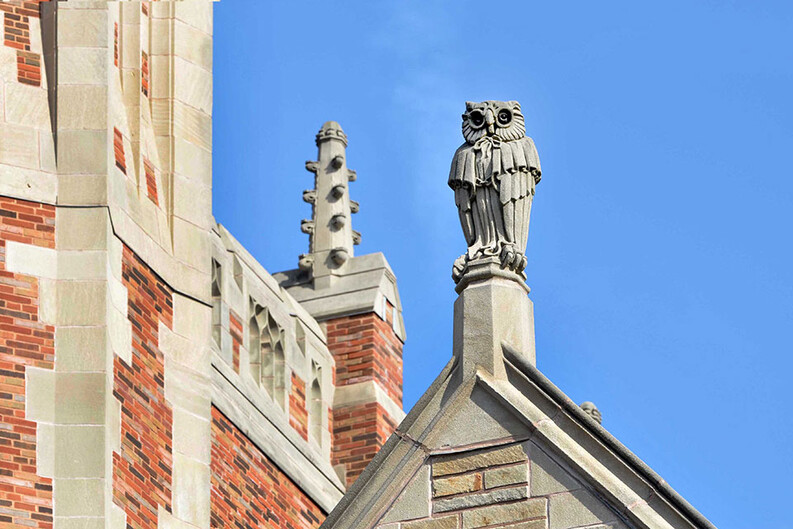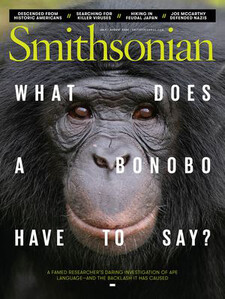Q & A: Lindsay Stern Ph.D. ’23 on Bonobo Language and Her New Cover Story in Smithsonian

This month’s issue of Smithsonian magazine features a cover story by LEAP student fellow Lindsay Stern4, Comparative Literature Ph.D. candidate and author of the novel The Study of Animal Languages5. Her article, “What Can Bonobos Teach Us about the Nature of Language?6,” chronicles the controversial research program of Dr. Sue Savage-Rumbaugh, a researcher whose discoveries about bonobos rocked the primatology world with stories about bonobos fibbing for fun, distinguishing good and bad, following through on threats, apologizing, and forming culture with humans. Savage-Rumbaugh’s methodologies grew more unorthodox as her career went on—she once published a paper based off of interviews with her bonobos, even listing them as coauthors.
On the occasion of the article’s publication, I asked Lindsay a few questions about the reporting process and how it changed her understanding of language, humans, and animals.
—Noah Macey, LEAP Program Fellow

You recount the controversy surrounding the primatology research of Dr. Sue Savage-Rumbaugh, who discovered bonobos’ capacities to manipulate concepts and use language. Her methods and conclusions were unprecedented, and she received pushback both inside and outside of the scientific community. Did her findings call into question any of your assumptions about language and humanity?
Yes, but circuitously. Her work suggested to me that the assumptions I believed I’d already dispensed with, alleged Darwinian that I am, were still alive and kicking.
When I first learned about her project, I was skeptical of the idea that language was a “capacity” you could model experimentally. Other animals do it. But birdsong, ape hoots, bee dances, and whale clicks seem like gibberish from the outside. I was intrigued by Savage-Rumbaugh’s bold way of trying to circumvent this problem. In the confines of a laboratory, traditionally a site where animals are used as tools and then disposed of, she developed an independent lingua franca — a keyboard of about 350 abstract symbols corresponding to English words — and explored whether a group of fellow great apes would make use of it to communicate with us. They did, in evocative and occasionally witty ways that chilled me, even though I believed in the abstract that no Rubicon existed between our minds and those of other living beings.
I was also intrigued by how her work butted up against the limits of truth-making in science. She argued that controlled, replicable tests designed to measure the bonobos’ intelligence weren’t capturing what was most interesting about them. Coaxing the apes into repeating their quips, for instance, would destroy the novelty of the situation and hence their motive to communicate. When it came to modeling meaning-making, replicability — generally the hallmark of truth in science — would throw the baby out with the bathwater.
As someone with a background in linguistics, I was struck by how much of the controversy you describe revolved around how to define “language," which becomes this proxy for how we define humanity. How has your understanding of the relationship between language and membership in the human species changed thanks to this reporting?
You point out a compelling irony — as invested as we’ve traditionally been in the idea of “language” as our distinguishing gift, we’ve had a hard time agreeing on what it means. The “human” is not that different. If you look at the early modern thinkers whose ideas paved the way for the discipline we today call “experimental psychology,” you find that it’s a very supple category for them. Carolus Linnaeus, who coined the term “homo sapiens,” famously left the “sapiens” part blank for the first 10 editions of his Systema Naturae, penciling in the maxim “Nosce te Ipsum,” Latin for “know thyself.” Read in that light, the species name “sapiens” reads more like a Socratic wink than a nod to our superlative intellect.
As for the relationship between language and species membership, I’d say I’m even farther from a clear answer as a result of this reporting. But I still think J. M. Coetzee said it best [in his novel Disgrace], in the guise of a disgruntled professor of communications: “His own opinion, which he does not air, is that the origins of speech lie in song, and the origins of song lie in the need to fill out with sound the overlarge and rather empty human soul.”

In the article, you mention that your interest in animal languages preceded your discovery of the Great Ape Trust and Dr. Savage-Rumbaugh's work. How did you come to be interested in animal languages?
In college I stumbled on a paper7 by Kentaro Abe and Dai Watanabe suggesting that birds communicate using grammar. That electrified me, since “syntax” has for so long been understood as the sine qua non of language. Eventually that interest opened out into what has become for me the more evocative question, which is what’s behind this need to search for aspects of ourselves in the bodies and minds of other animals. And as a novelist, I was of course interested in the “animal” forces motivating the search.
One implication of the research out of the Great Ape Trust is that humans are not so exceptional as many would like to believe. But another is that apes are sentient and intelligent — and therefore deserving of rights and legal standing. You describe how Dr. Savage-Rumbaugh wrote an affidavit for a court case over whether great apes deserve legal personhood. Primatologists and philosophers have had some success8 in extending legal rights to great apes. Were the other primatologists you spoke to that mentioned these efforts? How do you think this sort of science should interact with notions of animal rights and animal welfare?
It’s a fascinating question. Primatologist Mary Lee Jensvold has written — aptly, it seems to me — that a “sharp division between human and nonhuman or between language and non-language is a fiction of Aristotle’s law of the excluded middle.” You could say the same of the way our legal system recognizes all entities under the sun as either “persons” and “things.” (It would be great if life were indeed that straightforward!) It seems clear that animals are not things in the sense that chairs are things. We certainly don’t act as though that’s true. At the same time, it’s not obvious to me that grafting the status of “personhood” onto them will result in meaningful changes in how we relate, especially when “personhood” as a legal category has rarely tracked the “human” as a living being. On the contrary, that status has traditionally protected property-owning males and corporations (not incidentally, also largely piloted by white males; history can be quite risk-averse!).
Your question brings to mind the work of Charles Siebert, who’s argued movingly that our best hope at this point is to wall ourselves off from other lifeforms to the extent possible. My heart goes out to the many animals in this country who find themselves in the ongoing Kafka story of having outlived the experiments — many of them invasive — to which they were hostage. A live question that came up in my interviews with primatologists was what do with these captive apes now. Should we encourage them to reproduce, for the sake of keeping the species alive? Jensvold, who runs the Fauna Foundation9 and interacts daily with chimps retired from zoos and experiments, told me: “In a thought experiment where it’s like, well, if they’re going to go extinct in the wild and your choice is to have some in cages, I’d say, to me, it isn’t worth it. Every which way you spin it, captivity is a deprivation situation.”
You’ve now written about animal languages as a novelist, in The Study of Animal Languages, and as a journalist—how were the experiences different?
The challenge of fiction for me involves the plunges you have to take into yourself to pursue the craft. It’s different with non-fiction. You slowly cultivate a thicket of voices and images and questions and episodes until you have something resembling woods. Then the difficult work begins of cutting a path into it—figuring out where to enter, how to guide the reader through the bramble so they never feel as lost in it as you often do.
Is there anything you wished there’d been space to include in the piece?
In 2009, reports surfaced that a chimp in a Swedish zoo had made a practice10 of hacking concrete disks from the artificial boulders in his enclosure, stockpiling them in the early mornings, and later hurling them at human visitors. Zookeepers castrated him in the fall of 2008. After recovering, the chimp kept fashioning these missiles, this time hiding them under clumps of hay. His story haunts me. It made it into early drafts of the piece but eventually ended up on the cutting floor.
Do you know what your next writing project will be about?
I’m working on a dissertation that brings a motley crew of thinkers to bear on the question you raised earlier, of what’s at stake in conceiving of animals, rivers, and mountains as “persons,” bearers of “rights.” But that’s still nascent.


